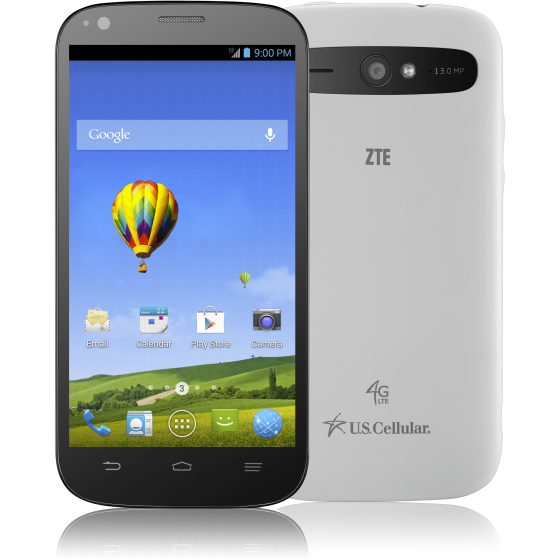ZTE's Grand S Pro Brings Processing Power on a Budget
ZTE has announced its most powerful budget-friendly smartphone yet: the Grand S Pro, featuring a 2.3 GHz Snapdragon SoC, and priced at just $250!
ZTE, a Chinese manufacturer of mostly low-end smartphones, is breaking into new territory with a very comfortably appointed mid-range offering.
“The Grand S Pro proves that it is possible to deliver a high-performing device, without the high price tag. This smartphone showcases ZTE’s definition of value which goes far beyond cost to deliver smart, affordable, quality choices.” - Lixin Cheng, Chairman and CEO of ZTE USA
With its SoC listed simply as MSM8974AB, we're not sure whether the ZTE Grand S Pro sports a Snapdragon 800 or Snapdragon 801 (we asked ZTE two days ago and are awaiting a response), but as we found out in Qualcomm Snapdragon 801: Performance Previewed, there's really only a marginal difference between these two chips. With an off-contract asking price of just $249.99, even if the Grand S Pro sports a Snapdragon 800, that's still a higher SKU than the $300 Google Nexus 5 (MSM8974AA) and not that far off from the much-anticipated OnePlus One's Snapdragon 801 MSM8974AC.
While the ZTE Grand S Pro packs some serious processing power for such an affordable device, the company had to skimp on a few things in order to hit that price point. The onboard storage for example, at just 8 GB, puts the ZTE Grand S Pro more in line with the $180 Motorola Moto G and Google's previous-generation Nexus 4. Fortunately, unlike most of its competition, the ZTE Grand S Pro's paltry storage space can be expanded with up to an additional 32 GB via a MicroSD card slot.
Unfortunately, the device's screen resolution is another area ZTE had to sacrifice. At just 1280 x 720, the Grand S Pro yet again has more in common with low-end and legacy launches. Still, games will likely run very smoothly on the phone due to the lower resolution display, so if mobile gaming is your thing but you need a phone on a budget, the ZTE Grand S Pro just might make sense for you.
The 5-inch IPS display, 2 GB of LPDDR3 memory, and 2300 mAh battery are pretty par for the course, as is the 2 MP front-facing camera. However, the 13 MP rear-facing camera with auto focus and LED flash is a cut above the phone's pricing tier.
Like many manufacturers, ZTE employs a custom skin for Android, consequently the Grand S Pro will debut with Android 4.3, with no word on future upgrades to KitKat (again, we asked and are awaiting a response from ZTE).
Get Tom's Hardware's best news and in-depth reviews, straight to your inbox.
Overall, the specifications for this phone are perhaps a bit off-balance. While the ZTE Grand S Pro may have presented a fantastic value proposition just a few months ago, an extra fifty dollar bill will get you a bigger and better screen, more internal storage, a bigger battery, more memory, better optics, and a faster SoC in the OnePlus One.
The ZTE Grand S Pro is available immediately through U.S. Cellular and will only set you back $99.99 with a two year contract. There has been no word on availability through other carriers just yet.
Follow Niels Broekhuijsen @NBroekhuijsen. Follow us @tomshardware, on Facebook and on Google+.
Niels Broekhuijsen is a Contributing Writer for Tom's Hardware US. He reviews cases, water cooling and pc builds.
-
hetneo "an extra fifty dollar bill will get you a bigger and better screen, more internal storage, a bigger battery, more memory, better optics, and a faster SoC in the OnePlus One."Reply
Well this phone is obviously made to entice people who wish to spend under $200 to stretch it to $250. Also, it's utterly inaccurate to say "will get you" considering OnePlus' One availability, and those limited supplies are more often priced closer to 400 euros in EU than to MSRP of $299. -
Raj5151 Today I learn useful stuff from this post. Thank youReply
<a href="http://techhowdy.com/asphalt-8-apk-free-download/?rel=ugc">asphalt 8 apk</a> -
outlw6669 I am really not sure why everyone is portraying 720p on a 5" screen as a bad thing.Reply
Not only will the lower resolution boost performance and battery life over a 1080p screen, it also reduces the BOM and, at ~294 PPI, it is still tack sharp.
Ideally, I would like to see 720p for devices up to 5.5" and 1080/1200P covering up to the 10" market.
Take the cost savings from a higher resolution screen and either roll it down to the customer or invest it in better build quality and more storage.






